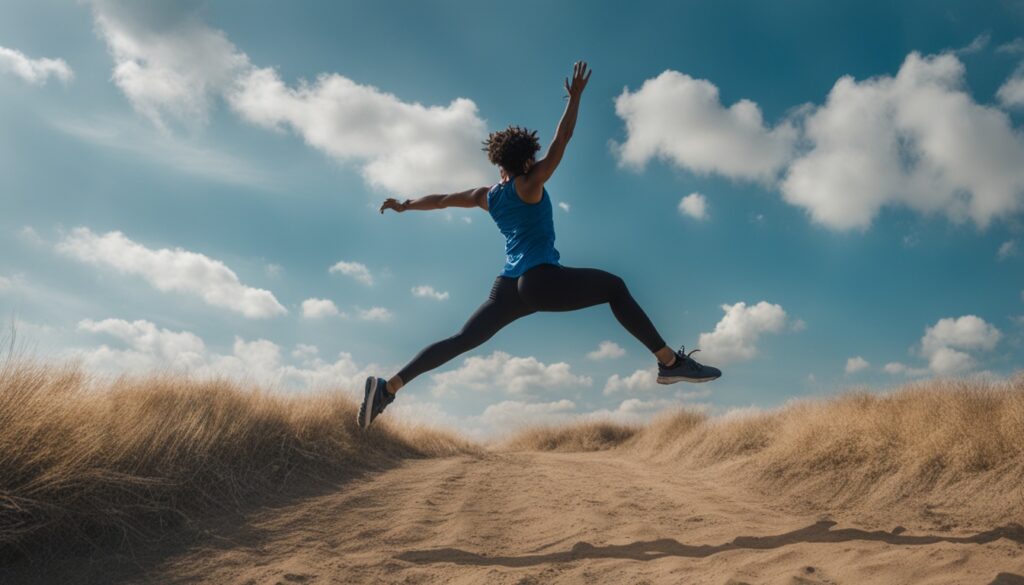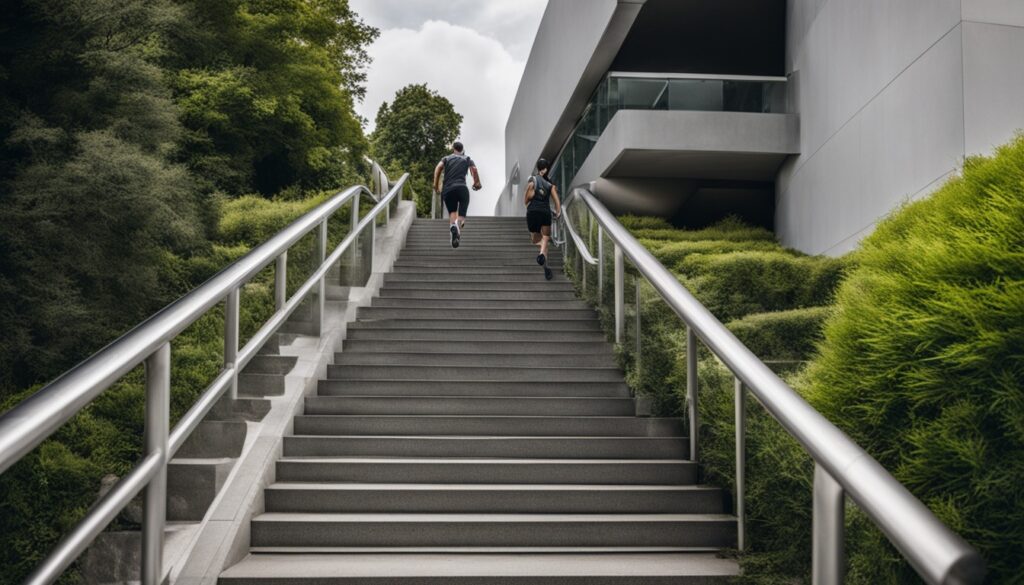Discover 10 simple exercises for health that can turn your living room into a fitness powerhouse. You don’t need a gym membership or expensive equipment. These simple exercises for health, bodyweight exercises, and low-impact workouts are easy and effective. They help you take care of your heart without leaving your house.
They’re perfect for busy people, stay-at-home parents, or anyone wanting to improve their beginner fitness routines and at-home workouts. These exercises boost your heart health, increase flexibility exercises and balance exercises, and help with stress relief exercises. All from the comfort of your own home.
The Importance of Regular Exercise
Benefits of Working Out
Regular exercise is key to a healthy life. It does more than just keep your body fit. It boosts your heart health and your mood, making life better overall.
Exercise is great for your heart. It makes the heart stronger and improves blood flow. This lowers the risk of heart problems. People who don’t move much are 44% more likely to feel depressed. This shows how important exercise is for your mind and body.
Working out also makes your muscles stronger and more flexible. Doing strength training two to three times a week helps a lot. Balance exercises three times a week can prevent falls and keep you independent as you get older.
Exercise does wonders for your mind too. It cuts stress, helps with depression and anxiety, and boosts your mood. In fact, 90 minutes of exercise each week can help as much as treatment for mild depression. It also makes you feel more energetic, helps you sleep better, and keeps your mind sharp.
The U.S. Department of Health and Human Services suggests adults get at least 150 minutes of moderate activity each week. This can be walking or swimming. Or, you can aim for 75 minutes of hard activity like running or swimming laps. For even more benefits, try to get 300 minutes a week or more of aerobic activity.
Adding exercise to your daily routine is key to staying well. It could be a simple walk, lifting weights, or dancing. Making exercise a part of your life changes your health in big ways, affecting your body, mind, and feelings.

Jumping Jacks
Jumping jacks are a classic exercise that work your whole body. They start with your feet together and arms by your sides. Then, you jump and spread your legs wide while raising your arms above your head. This movement is great for your heart health and fitness.
As a cardiovascular exercise, jumping jacks boost your heart rate. This strengthens your heart and makes it pump more efficiently. It also helps with blood circulation, making sure oxygen and nutrients reach your body’s tissues.
Jumping jacks are also great for burning calories. This can help with weight management and ease the heart’s workload. They work many muscles, like your glutes, hips, and shoulders, making them a full-body exercise.
Adding jumping jacks to your workout can greatly improve your health and fitness. They’re good for warming up, high-intensity training, or as a standalone exercise. Jumping jacks are a versatile way to boost your heart health and overall fitness.
| Benefits of Jumping Jacks | Key Statistics |
|---|---|
|
|

Stair Climbing
Stairs are a great way to get a cardio workout right in your home. Stair climbing is a mix of aerobic exercise and strength training. It’s perfect for keeping your heart healthy.
Tips for a Cardio Workout
Start by finding stairs and walk at a moderate pace. As you get fitter, speed up. For a tougher workout, try taking two steps at once to work more muscles.
Experts say beginners should start with 2 to 5 minutes of stair climbing. Then, increase the time as you get more comfortable. Aim for a workout intensity from 1 to 10. Walk up stairs, add arms and speed in the second set, and go all out in the third set.
When stair climbing, safety first to avoid getting hurt. Wear shoes with good grip and support. Keep your posture right and use the railing for balance if needed. Using a towel on the machine’s console is better than holding the rails to protect your wrists and shoulders.

Going down stairs can be hard on your body, especially if you’re new to it. It can make your legs sore. To lessen the impact, try using the elevator or change your foot position when going down.
Start stair workouts slowly and don’t jump into hard exercises too fast. Follow the FITT principles (Frequency, Intensity, Time, and Type) to avoid getting overwhelmed.
High Knees
High knees are a dynamic cardio exercise that boost your heart rate and engage many muscles. They improve your cardiovascular endurance. This workout feels like running in place, asking you to lift your knees up towards your chest quickly.
To do high knees, stand with your feet hip-width apart. Keep your core tight and your posture straight. Start by lifting one knee towards your chest as high as you can. Then, quickly switch to the other knee, keeping up a fast pace.
Swing your arms in sync with your legs to help move your body and stay balanced. High knees are great for your health and fitness. They make your heart rate go up, making your heart stronger and more efficient.
High knees also help with blood flow and oxygenation. This makes you more aerobically fit overall.
High knees work out many muscles, like your quadriceps, glutes, hip flexors, and calves. This helps build muscle strength and endurance over time.
High knees are perfect for warming up, adding to circuit training, or doing HIIT. Start at a pace you’re comfortable with and increase the intensity as you get better at it.

Fast Feet
Fast feet is a fun agility drill that boosts cardiovascular fitness by moving your feet quickly. Start in a slight squat with your feet hip-width apart. Then, quickly shuffle your feet back and forth, keeping them close to the ground. It’s like tapping hot coals with your feet.
This exercise is great for heart health. It makes your heart rate go up fast, which builds cardiovascular endurance and strengthens your heart. The quick movements also help with blood circulation. This means your body gets oxygen and nutrients better.
Fast feet drills also make your feet work together better and improve agility. This is key for staying fit and helps prevent injuries.
| Exercise | Benefits |
|---|---|
| Fast Feet |
|
Adding fast feet to your workouts is a great way to get fit. It’s a high-intensity agility drill that helps with cardiovascular fitness, blood circulation, and injury prevention. Try doing it a few times a week for the best results.
Imaginary Jump Rope
Technique
Looking for a fun cardio exercise without equipment? Try the imaginary jump rope. It mimics traditional jump roping, giving you heart health benefits without a rope.
Start by standing with your feet apart and arms at your sides. Hold your fists as if you’re gripping a rope. Then, rotate your wrists to make the rope move in your mind.
As you turn your wrists, hop lightly off the ground. Keep a steady rhythm. Use your arms and shoulders like you would with a real rope.
This imaginary jump rope exercise boosts your heart rate and burns calories. It also improves coordination and balance. You need to move your arms, legs, and body together to keep the rhythm.
It fits well into HIIT routines, offering a cardio workout without special gear. The imaginary jump rope is great for fitness, coordination, or just fun workouts.
| Metric | Value |
|---|---|
| Rep Count | Each invisible jump rope counts as 1 rep |
| Workout Duration | 8 minutes |
| Exercise Duration | 60 seconds per exercise |
| Total Exercises | 10 |
| Jump Rope Jacks Duration | 60 seconds |
| Traveling Over and Back Duration | 30 seconds |
| Double Under Jump Rope | Swing the rope in two full rotations under your feet before landing |
The imaginary jump rope is a great way to enjoy jump roping without equipment. It gets your heart rate up, improves coordination and balance, and fits into HIIT routines.
Squats
Squats are key for building strength in the lower body and engaging the core. Dr. Damian Bailey’s research shows they’re great for fitness. They help with a healthy lifestyle.
Proper Squat Technique
Start with your feet shoulder-width apart, toes a bit out. Pull in your core and keep your chest up as you bend your knees and hips. Act like you’re sitting back into a chair.
Make sure your knees don’t go past your toes. Your weight should be on your heels and the balls of your feet. Go down until your thighs are at ground level, or as far as you can safely.
Then, push through your heels to stand up again. Keep your core engaged the whole time.
Doing squats right works out your lower body. It targets the quadriceps, hamstrings, and glutes. It also works many muscles at once. This can make your heart rate go up, boost cardiovascular health, and improve flexibility and mobility.
| Muscle Group Targeted | Benefit |
|---|---|
| Quadriceps | Improved leg strength and power |
| Hamstrings | Enhanced lower body flexibility and injury prevention |
| Glutes | Increased hip and leg strength for better athletic performance |
| Core | Strengthened abdominal and back muscles for improved posture and stability |
Adding squats to your workout routine brings many benefits for a healthy life. They’re good for everyone, from beginners to pros. Learning the right squat form can greatly improve your lower body strength, core engagement, and cardiovascular health.
Lunges
Lunges are a key exercise that work your quadriceps, hamstrings, glutes, and calves. They are essential for any fitness plan. This exercise boosts lower body strength and tests your balance and stability.
To do a lunge, stand up straight with your feet shoulder-width apart. Move one leg forward, lowering your body until both knees bend at a 90-degree angle. Make sure your front knee is right over your ankle, not past it. Keep your back straight and engage your core as you move.
- Lunges work and strengthen the main muscles in your lower body.
- This exercise raises your heart rate, giving you a cardio boost.
- Lunges release endorphins, making you feel energized and happy.
There are many lunge variations to try, targeting different muscles and keeping workouts interesting. You can do forward lunges, reverse lunges, or even add weights for more challenge. Aim for 8-12 reps per set and increase the weights as you get stronger.
Lunges do more than just build lower body strength. They also improve balance and functional movement. The exercise works on stabilizing muscles, helping to fix imbalances and boost stability. Adding lunges to your routine can change your fitness journey, helping with weight loss, injury prevention, and more.
Planks
Planks are a simple yet effective exercise that work your core muscles. They give you a full-body workout in one move. By working your abs, shoulders, arms, and legs, planks build core strength, improve posture, and boost heart health.
To do a plank, start in a pushup position with your hands and toes on the ground. Keep your back straight, core tight, and chin a bit tucked in. Breathe deeply and keep your body tense, making sure your abs, shoulders, triceps, glutes, and quads work together.
Planks do more than just strengthen your core. They also engage your whole body, which can boost your cardiovascular benefits by raising your heart rate. Plus, a strong core from regular planking helps with balance and stability. This reduces the chance of getting hurt during other activities.
| Plank Variation | Benefits |
|---|---|
| Traditional Plank | Targets the abdominal muscles, shoulders, and arms |
| Side Plank | Challenges the oblique muscles and improves lateral core strength |
| Reverse Plank | Engages the back muscles and promotes overall core stabilization |
Adding planks to your workout can change the game. It helps build a stronger, more stable core and gives you the cardiovascular benefits of a great exercise. Start with 10-second holds and increase the time as you get stronger. Embrace the challenge and enjoy the benefits of a well-rounded, full-body engagement workout.
Simple exercises for health
Staying active with simple exercises can greatly improve your health and happiness. These exercises are great for busy people, parents, or anyone wanting to get fitter. You can do them anywhere, anytime, without needing any special equipment.
Experts say that moving more and exercising regularly is key to a healthy life. Just 150 to 300 minutes of moderate activity each week can make your heart healthier, build muscle, and lift your mood. Sadly, most Americans don’t meet these activity goals.
We’ve put together a list of simple exercises you can do at home with just your body. These exercises are perfect for beginners and fit easily into your daily routine.
- Chair Lunges: Stand in front of a sturdy chair, take a large step forward with one leg, and lower your body until your front thigh is parallel to the ground. Push back to the starting position and repeat on the other side.
- Leg Lifts: Lie on your back with your hands at your sides, palms down. Slowly lift one leg straight up towards the ceiling, hold for a moment, and then lower it back down. Repeat with the other leg.
- Hip Bridges: Lie on your back with your knees bent and your feet flat on the floor. Lift your hips off the ground, forming a straight line from your knees to your shoulders, and then lower back down.
- Core Twists: Sit on the floor with your knees bent and your feet flat. Twist your upper body to one side, reaching your arms across your body, and then return to the center. Repeat on the other side.
- Downward Dog: Start on your hands and knees, with your hands slightly in front of your shoulders. Push your hips up and back, creating an inverted “V” shape with your body, and hold the pose.
Always warm up for 3-5 minutes before starting your simple exercises. Do 6-10 reps of each exercise, 2-3 times. These bodyweight exercises can make you healthier and happier, all from home.
Premier Health is a top healthcare provider with wellness programs to help you live healthier. They offer wellness centers, nearsite, and virtual options. Premier Health aims to help you exercise regularly and live a balanced life.
Pushups
Pushups are a key exercise that work many muscles. They are great for any fitness plan. This exercise targets the arms, chest, shoulders, and core. It helps build strength and improves muscle engagement.
To do a pushup right, start in a plank with your hands shoulder-width apart. Your arms should be straight, and your core tight. Bend your elbows to lower your body until your chest touches the ground. Then, push back up, keeping your elbows near your body. Keeping proper form is key to getting the most out of the exercise and staying safe.
If pushups are new to you or hard, try different versions. Knee pushups are easier and help build up to full pushups. Incline pushups, with your hands on a higher surface, are also easier for beginners.
| Pushup Variation | Muscle Engagement | Difficulty Level |
|---|---|---|
| Standard Pushup | Chest, Shoulders, Triceps, Core | Intermediate to Advanced |
| Knee Pushup | Chest, Shoulders, Triceps | Beginner |
| Incline Pushup | Chest, Shoulders, Triceps | Beginner to Intermediate |
| Decline Pushup | Chest, Shoulders, Triceps | Intermediate to Advanced |
Adding pushups to your workout routine has many benefits. It helps keep bones and muscles strong, controls weight, improves posture, and lowers the risk of chronic diseases. Doing pushups regularly helps you get stronger and ready for harder versions over time.
Start with a few pushups and increase the number as you get stronger. Getting advice from a personal trainer or doctor is a good idea if you’re new to exercise. They can help you do the exercise safely and effectively.
Glute Bridges
The glute bridge is a great exercise for the whole posterior chain. It works the glutes, hamstrings, and lower back. This simple move boosts your strength, power, and athletic skills.
To do a glute bridge, start by lying on the floor with knees bent and feet flat. Engage your core, squeeze your glutes, and push through your heels to lift your hips. Keep your body in a straight line from knees to shoulders. Hold it for a moment, then slowly go back down. Do this for as many reps as you want.
Strengthening Your Glutes
Glute bridges are great for making your glutes stronger. These muscles are the biggest and strongest in your body. This exercise targets the posterior chain, boosting your glute strength and muscle activation.
Strengthening your glutes helps with everyday activities and complex movements like deadlifts and squats.
For a tougher challenge, try single-leg bridges, weighted bridges, or paused bridges. These versions target different muscles and make the exercise harder.
It’s important to do glute bridges correctly to avoid injury and get the most benefits. Keep your core engaged, shoulders, hips, and knees in line, and squeeze your glutes at the top.
Adding glute bridges to your workout can change the game for a strong, balanced lower body. It targets the posterior chain, strengthening your glutes and boosting your muscle activation and athletic performance.
Burpees
Burpees are a full-body exercise that boost both your heart health and muscle strength. They combine a squat, plank, push-up, and jump into one move. This makes them great for those looking for a tough yet rewarding workout.
To do a burpee, start by standing with your feet apart and arms by your sides. Then, squat down and put your hands on the ground. Next, jump back into a plank position, keeping your body straight from head to heels.
Do a push-up, then jump your feet back towards your hands. Finally, stand up, raise your arms, and jump up.
Burpees are great for your heart health. Most people can do about 20 burpees a minute, burning 250 calories for a 155-pound person in 20 minutes. This type of exercise is known as HIIT and is effective for losing fat and getting fit.
Burpees also help build muscle strength. They work your arms, chest, shoulders, abs, legs, hips, and glutes. Studies show that doing vigorous exercises like burpees can help you live longer.
Start with a few burpees and increase the number as you get stronger. Make sure to do them correctly before adding weights or variations to avoid getting hurt. You can make them harder by doing box jumps or using a Bosu ball.
Adding burpees to your workout can make your heart and lungs stronger. It can also improve blood flow and lower the risk of heart disease and diabetes. Burpees are a great way to get cardio and strength training in one move, helping you live a healthy, active life.
Conclusion
This article shows you how to boost your health and fitness at home. By doing simple exercises, you can improve your heart health, strength, and flexibility. You won’t need expensive gym memberships or special gear.
These exercises are great for anyone, whether you’re busy, a stay-at-home parent, or just starting your fitness journey. They make it easy to take care of your body and heart. Adding these home workouts to your routine will help you become healthier and more active. You’ll see better heart health, flexibility, and strength training.
Just spend a few minutes each day on these exercises to see big improvements in your health. Start adding these simple yet powerful exercises to your daily life today. Your body and mind will appreciate the positive changes.
FAQ
What are the key benefits of the exercises featured in this article?
These exercises boost your heart health, build muscle strength, increase flexibility, and lower stress. You can do them at home with no special gear.
How do the exercises help to improve heart health?
Exercises like jumping jacks and stair climbing raise your heart rate. This strengthens your heart and boosts blood flow. This can cut down heart disease risk and enhance your heart fitness.
What makes these exercises suitable for beginners?
They’re easy and open to everyone, even beginners. You can adjust them to fit your skill level. This lets you move forward at your pace.
How often should I perform these exercises?
Do these exercises daily for best health benefits. Try different ones a few times a week. This lets your body rest and heal.
Can these exercises be combined with other fitness routines?
Yes! Add them to your current workout or start a new one. They fit well with HIIT, strength training, and cardio routines.
Are any special equipment or gym memberships required?
No special gear or gym memberships needed. Just your bodyweight is enough. You can exercise at home anytime.
How can these exercises help with stress management?
Exercises like planks and glute bridges reduce stress by releasing endorphins. Regular exercise also helps with anxiety and depression, improving life quality.
Can these exercises help with weight management?
Yes, they’re great for weight control. High-energy activities like jumping jacks burn lots of calories. Combine them with a healthy diet for better weight management.
Are there any safety considerations I should be aware of?
Focus on proper form to avoid injuries. Start slow if you’re new or have health issues. Always warm up and drink water during your workout.
How can I track my progress with these exercises?
Keep an eye on reps, exercise time, and intensity. Over time, you’ll see better strength, endurance, and fitness as you stick with these exercises.

